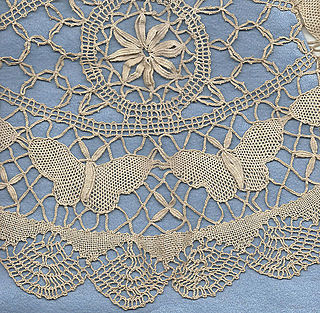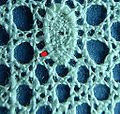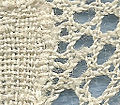
Lace is a delicate fabric made of yarn or thread in an open weblike pattern, made by machine or by hand. Generally, lace is divided into two main categories, needlelace and bobbin lace, although there are other types of lace, such as knitted or crocheted lace. Other laces such as these are considered as a category of their specific craft. Knitted lace, therefore, is an example of knitting. This article considers both needle lace and bobbin lace.

Bobbin lace is a lace textile made by braiding and twisting lengths of thread, which are wound on bobbins to manage them. As the work progresses, the weaving is held in place with pins set in a lace pillow, the placement of the pins usually determined by a pattern or pricking pinned on the pillow.
Filet lace is the general word used for all the different techniques of embroidery on knotted net. It is a hand made needlework created by weaving or embroidery using a long blunt needle and a thread on a ground of knotted net lace or filet work made of square or diagonal meshes of the same sizes or of different sizes. Lacis uses the same technique but is made on a ground of leno or small canvas.

Guipure lace is a type of bobbin lace. It connects the motifs with bars or plaits rather than net or mesh.

Freehand lace is bobbin lace worked directly on the fabric of the lace pillow without using a pricked pattern. Very few pins are needed

Warp knitting is defined as a loop-forming process in which the yarn is fed into the knitting zone, parallel to the fabric selvage. It forms vertical loops in one course and then moves diagonally to knit the next course. Thus the yarns zigzag from side to side along the length of the fabric. Each stitch in a course is made by many different yarns. Each stitch in one wale is made by several different yarns.

Knitted fabric is a textile that results from knitting, the process of inter-looping of yarns or inter-meshing of loops. Its properties are distinct from woven fabric in that it is more flexible and can be more readily constructed into smaller pieces, making it ideal for socks and hats.
The manufacture of textiles is one of the oldest of human technologies. To make textiles, the first requirement is a source of fiber from which a yarn can be made, primarily by spinning. The yarn is processed by knitting or weaving, which turns yarn into cloth. The machine used for weaving is the loom. For decoration, the process of colouring yarn or the finished material is dyeing. For more information of the various steps, see textile manufacturing.

Valenciennes lace is a type of bobbin lace which originated in Valenciennes, in the Nord département of France, and flourished from about 1705 to 1780. Later production moved to Belgium, in and around Ypres. The industry continued onto the 19th century on a diminished scale. By the 19th century Valenciennes lace could be made by machine.

Mechlin lace or Point de Malines is an old bobbin lace, one of the best known Flemish laces, originally produced in Mechelen. Worn primarily during summer, it is fine, transparent, and looks best when worn over another color. Used for women's clothing, it was popular until the first decade of the 20th century. It was made in Mechelen, Antwerp, Lier and Turnhout. It was used for coiffures de nuit, garnitures de corset, ruffles and cravats.

Brussels lace is a type of pillow lace that originated in and around Brussels. The term "Brussels lace" has been broadly used for any lace from Brussels; however, strictly interpreted, the term refers to bobbin lace, in which the pattern is made first, and the ground, or réseau added, also using bobbin lace. Brussels lace is not to be confused with Brussels point, which is a type of needle lace, though sometimes also called "Brussels lace".

Torchon lace is a bobbin lace that was made all over Europe. It is continuous, with the pattern made at the same time as the ground. Torchon lace is notable for being coarse and strong, as well as its simple geometric patterns and straight lines. It does not use representational designs. Torchon lace was used by the middle classes for edging or insertion, and also to trim cotton and linen underwear, where it was ideal because of its strength and because it was inexpensive. Torchon lace was originally made from flax, but cotton is used as well, and has been for a long time. It is made in strips 1 to 2 inches wide. Torchon lace generally has a gimp outlining the pattern. The gimp was first used in Sweden, but now is used generally. Colored threads are occasionally used, but in general Torchon lace is white.

Honiton lace is a type of bobbin lace made in Honiton, Devon, in the United Kingdom. Historical Honiton lace designs focused on scrollwork and depictions of natural objects such as flowers and leaves.

Lace machines took over the commercial manufacture of lace during the nineteenth century.

Part lace or sectional lace is a way of making bobbin lace. It characterises various styles, such as Honiton lace or Brussels lace.

Flanders lace was made in Flanders, which was particularly well known for its bobbin lace. The supreme epoch of Flemish lace lasted from about 1550-1750.
Bobbin lace ground is the regular small mesh filling the open spaces of continuous bobbin lace. Other names for bobbin lace ground are net or réseau. The precise course of the threads and the resultant shape of the ground are an important diagnostic feature in lace identification, as different lace styles use different grounds.

The lace curtain machine is a lace machine invented by John Livesey in Nottingham in 1846. It was an adaptation of John Heathcoat's bobbinet machine. It made the miles of curtaining which screened Victorian and later windows.

Ipswich lace is a historical fashion accessory, the only known American hand-made bobbin lace to be commercially produced. Centered in the coastal town of Ipswich, Massachusetts north of Boston, a community of lacemaking arose in the 18th century. Puritan settlers to the area likely made and wore lace as early as 1634, because Sumptuary laws from the early colonial records indicate this activity. Earliest known records of the commercial production indicate that lace produced by local women was used to barter for goods in the 1760s, as denoted by ledger account books belonging to local merchants. These laces were sold in the region from Boston to Maine.
Cogne lace is a handmade bobbin lace that is made in Cogne, in the Aosta Valley in Italy. It takes the form of strips of lace, due to the manner in which it is made on a drum.

























